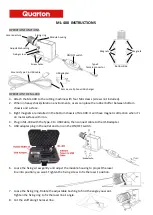
12
GMC-I Messtechnik GmbH
5
Insulation Resistance Measurement
– Riso/Rins Function
5.1
Connection
Note
Checking the Measurement Cables
Before performing insulation measurement, the test
probes on the measurement cables should be short-cir-
cuited in order to assure that the instrument displays a
value very close to 0
This makes it possible to detect interrupted measurement
cables, which simulate high insulation resistance.
Ð
Connect the device under test to the
+
and
COM
jacks.
Sample connection layouts for insulation resistance measurement
are included in section 13.1.
Note
Insulation resistance can only be measured at voltage-
free objects. The measurement cannot be started until
the test probes are in contact with the device under test.
If line voltage or interference voltage of greater than 50 V
is applied to the measurement inputs, this is indicated by
means of a double acoustic signal. Insulation measure-
ment cannot be started as long as interference voltage is
present.
5.2
Executing the Measurement
Note:
Condensation must be ruled out when performing measure-
ments at close to the freezing point.
Ð
Select the measuring function, as well as the desired test volt-
age depending on the device under test, with the rotary
switch, e.g. R
iSO
100 V.
Attention!
!
Do not touch the instrument’s terminal contacts or the
conductive ends of the two test probes during insulation
resistance measurement!
If nothing has been connected to the terminal contacts, or if a
resistive load component has been connected for measurement,
your body would be exposed to a maximum short-circuit current.
The resulting electrical shock is not life endangering. However, the
noticeable shock may lead to injury (e.g. resulting from a startled
reaction etc.).
Ð
Start an individual measurement by briefly pressing the
START
key, or initiate continuous measurement by briefly pressing
the
CONTIN./
ZERO
key.
Ð
Contact the measuring point with both test probes.
A double acoustic signal indicates that measurement has been
started.
The
Caution! LED
remains illuminated for as long as test voltage
is applied to the test probes.
LED
➀
lights up to indicate that the upper measuring range of
10 k
1 T
has been complied with (default setting).
Ð
Wait until the pointer settles in. Depending on the device
under test, this may take anywhere from several seconds to
half a minute if, for example, large capacitors (long cables)
have to be charged.
Ð
Read the measured value from the upper voltage scale
➀
.
If the
Limit
LED lights up green, the insulation measurement is
valid and the limit value has not been violated.
If the limit value is fallen short of, the
Limit
LED lights up red.
!
www.calcert.com
1.888.610.7664
0
5
10
15
20
25
30













































